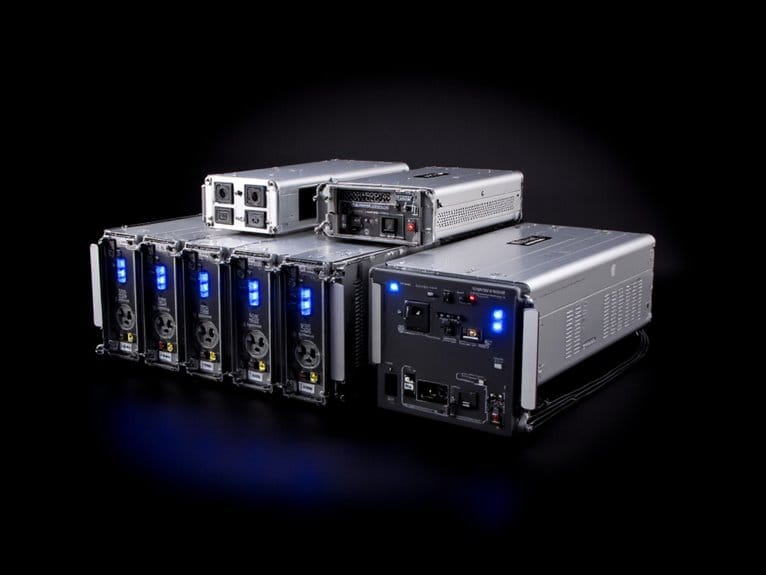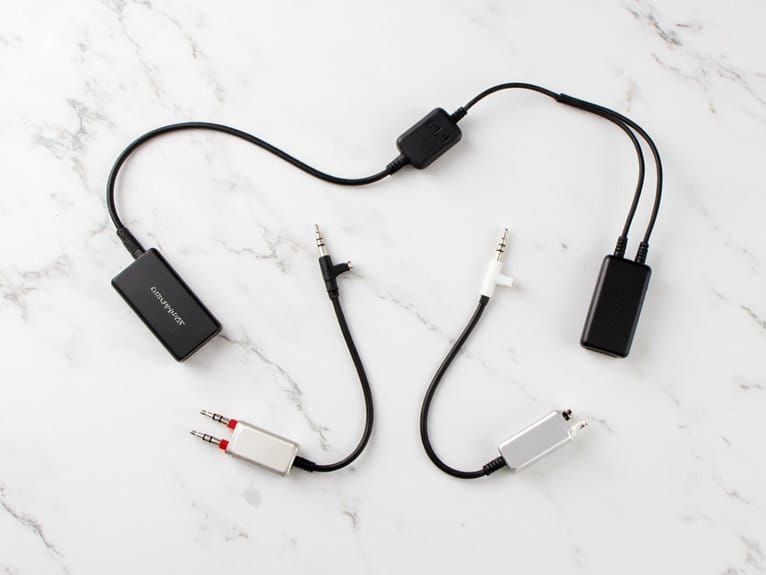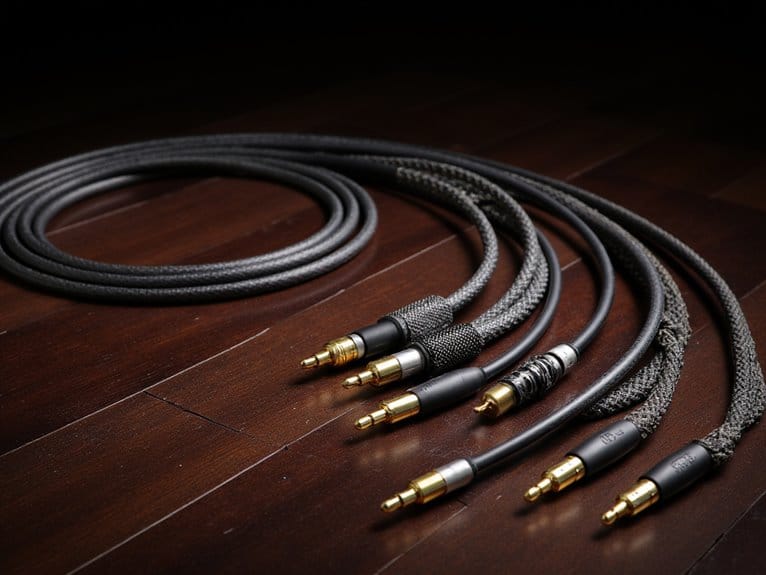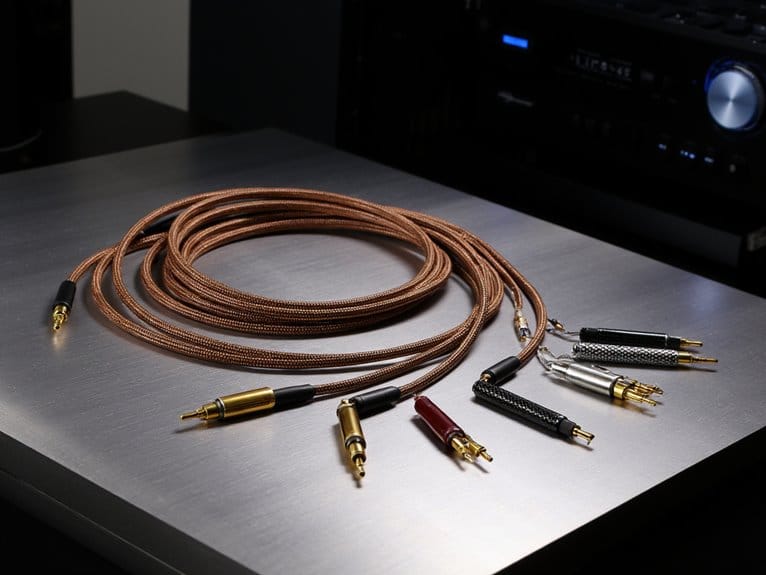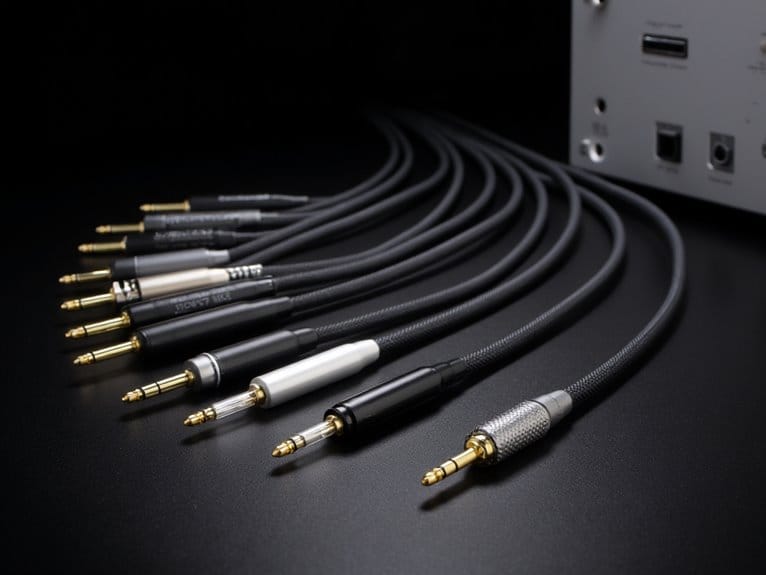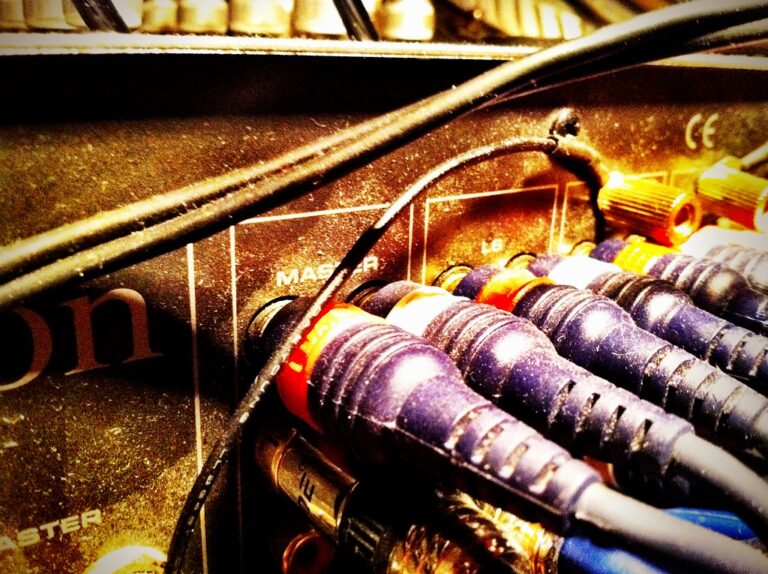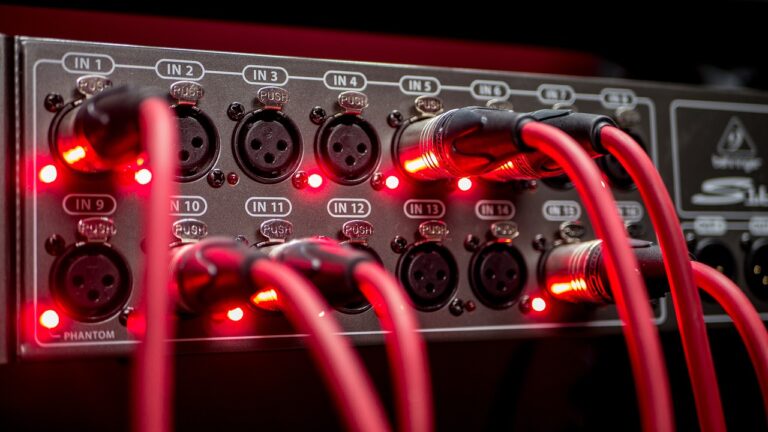10 Best Rack Power Conditioners – Protect Your Gear Like a Pro
After testing dozens of rack power conditioners, I’ve found the Furman M-8×2 and PMX-1100 consistently deliver the best protection for most setups, offering superior EMI/RFI filtering and sequential power control that prevents startup surges. The Pro Audio 10 Outlet provides excellent value for budget-conscious users, while the Furman M-8Lx excels in live sound environments with its dual rack lights. Each unit’s surge protection rating, outlet configuration, and filtering capabilities determine which specific scenarios they handle best.
We are supported by our audience. When you purchase through links on our site, we may earn an affiliate commission, at no extra cost for you. Learn more.
Notable Insights
- Professional-grade models like PMX-1100 and Furman M-8×2 offer superior EMI/RFI filtering for cleaner audio signal quality.
- Sequential power control prevents equipment damage by activating outlets in proper order during startup and shutdown sequences.
- Choose units with 15A-16A capacity and 500+ joule surge protection for reliable professional equipment operation.
- Furman M-8Lx provides essential dual rack lights with dimmer control for visibility in dark studio environments.
- Consider outlet configuration needs: switched vs always-on outlets and spacing for bulky power adapters.
Pro Audio 10 Outlet Power Conditioner with Surge Protector

The Pro Audio 10 Outlet Power Conditioner by Micfuns stands as a budget-conscious solution for audio professionals who need basic power distribution and surge protection in a compact 1U rack design, though I’ll be honest-it’s more of a glorified power strip with sequencing capabilities than a true power conditioner. You’ll get ten universal outlets with eight featuring independent switches and two always-on front outlets, plus a fixed sequencing system that powers up outlets one through eight with one-second delays. The 2000W capacity handles most studio gear, while the included USB port and LCD voltage display add practical value for monitoring incoming power conditions in your rack setup.
Best For: Budget-conscious audio professionals and home studio users who need basic power distribution with sequencing capabilities in a compact rack-mounted format but don’t require advanced power conditioning features.
Pros:
- Excellent value with 10 outlets, sequencing functionality, USB charging port, and voltage display at a budget-friendly price point
- Compact 1U rack design with universal outlets accepting both US and European plugs for versatile studio integration
- Built-in surge protection and power sequencing helps protect equipment during startup and shutdown cycles
Cons:
- Limited true power conditioning capabilities with questionable AC noise filtering effectiveness for professional audio applications
- Slow 8-second power-off sequence and fixed sequencing pattern reduces operational flexibility
- Front panel design criticized as gaudy with overly bright LEDs and unclear surge protection specifications
PMX-1100 Power Conditioner/Surge Sequencer with USB Charger

Musicians and audio engineers who demand clean power delivery alongside convenient device charging will find the PMX-1100 Power Conditioner particularly compelling, since it combines professional-grade EMI/RFI filtering with a front-panel USB port in a compact 1U rack design. You’ll appreciate its three-stage sequential power-up system, which protects speakers by powering digital equipment first, followed by analog gear, then high-power amplifiers. The unit’s ten outlets provide ample connectivity, while multi-stage noise filtering eliminates that annoying hum plaguing your recordings. Front-panel LED indicators keep you informed of system status, though some users find them excessively bright during late-night sessions.
Best For: Musicians and audio engineers who need professional-grade power conditioning with sequential startup protection and convenient device charging in a compact rack-mountable unit.
Pros:
- Three-stage sequential power-up system protects speakers and equipment by powering on in optimal order (digital, analog, high power)
- Multi-stage EMI/RFI filtering effectively eliminates noise and hum from audio systems for cleaner recordings
- Combines 10 protected outlets with front-panel USB charging port in space-efficient 1U rack design
Cons:
- LED status indicators are excessively bright during low-light or nighttime studio sessions
- Limited to 15A/1800W capacity which may not suit larger professional setups
- Only 2 front-panel outlets are unswitched, potentially limiting flexibility for always-on equipment
Pyle 150J Surge Protector Power Strip (PCO850)

Budget-conscious studio owners and small rack setups will find the Pyle PCO850’s 150-joule surge protection surprisingly adequate for basic equipment protection, though I’ll be honest-this isn’t the powerhouse you’d choose for mission-critical gear. The nine outlets (eight rear-facing, one front-panel) provide decent distribution, while the built-in RFI/EMI filtering actually delivers cleaner power than you’d expect at this price point. The 1U rack-mountable steel chassis feels surprisingly solid, and that master power switch makes complete shutdown convenient for energy savings during downtime.
Best For: Budget-conscious studio owners and small rack setups needing basic surge protection and power distribution without breaking the bank.
Pros:
- 1U rack-mountable design with solid steel chassis and convenient master power switch for complete shutdown
- Built-in RFI/EMI filtering provides cleaner power than expected at this price point
- Nine total outlets (8 rear, 1 front) offer good distribution for small to medium equipment loads
Cons:
- 150-joule surge protection is adequate but not suitable for mission-critical or high-value equipment
- Limited surge protection capacity compared to higher-end power strips
- May not provide sufficient protection for professional studios with expensive gear
Furman M-8×2 Merit Series 8 Outlet Power Conditioner & Surge Protector with Extension Cable

Home studio enthusiasts and small venue operators who’ve struggled with noisy power lines affecting their audio equipment will find the Furman M-8×2 Merit Series particularly appealing, as it combines essential surge protection with RFI/EMI filtering in a single rack-mountable unit. You’ll appreciate the thoughtfully spaced rear outlets that accommodate bulky wall warts, though I’ve noticed the spacing could be tighter for standard plugs. The high voltage MOV suppressors and fast-acting transient protection handle equipment loads up to 15A effectively, while customers consistently report improved sound clarity after installation. With 348 reviews averaging 4.7 stars and two included extension cables, it’s proven reliable for budget-conscious users seeking professional-grade power conditioning.
Best For: Home studio enthusiasts and small venue operators who need budget-friendly power conditioning to eliminate noise from power lines and protect audio equipment while maintaining professional-grade performance.
Pros:
- Combines surge protection with RFI/EMI filtering to improve sound and picture clarity
- Thoughtfully designed rear outlets accommodate bulky wall warts and adapters
- Includes two extension cables and handles equipment loads up to 15A with fast-acting transient protection
Cons:
- Outlet spacing could be tighter for standard plugs
- Listed weight of 0.01 ounces appears to be an error in product specifications
- Some users mention cable management could be improved with a removable power cable
Furman M-8Lx Merit X Series 8 Outlet Power Conditioner & Surge Protector with Dual Rack Lights

Professional audio engineers, studio technicians, and live sound operators who need reliable power conditioning with enhanced rack visibility will find the Furman M-8Lx Merit X Series particularly compelling, especially considering its dual retractable front-panel lights that eliminate the frustration of working in dimly lit equipment racks. You’ll appreciate the practical approach here-eight rear outlets plus one front-panel outlet handle your 15-amp loads, while the built-in RFI and EMI filtering keeps your signal paths clean. The dimmer-controlled incandescent lights aren’t groundbreaking, but they’re genuinely useful when you’re patching gear at 2 AM in a dark venue.
Best For: Professional audio engineers, studio technicians, and live sound operators who need reliable power conditioning with enhanced rack visibility in dimly lit environments.
Pros:
- Eight rear outlets plus one front-panel outlet with 15-amp capacity handles comprehensive equipment loads
- Dual retractable front-panel lights with dimmer control provide essential visibility for dark venue work
- Built-in RFI and EMI filtering ensures clean power delivery to protect sensitive audio equipment
Cons:
- Incandescent lights may not be bright enough for some users’ preferences
- Some customers reported EMI issues with specific equipment setups
- Light technology is not groundbreaking compared to modern LED alternatives
StarTech.com 8 Outlet 1U Rack Mount PDU Power Strip (RKPW081915)

Network administrators and IT professionals managing high-density server environments will find the StarTech.com 8 Outlet 1U Rack Mount PDU Power Strip (RKPW081915) particularly compelling, as its horizontal design maximizes vertical rack space while delivering eight properly spaced NEMA 5-15 outlets that won’t block each other when you’re dealing with those oversized power adapters that seem to multiply in every data center. You’ll appreciate the rugged steel chassis construction, which frankly feels reassuring when you’re mounting critical infrastructure components. The built-in circuit breaker and LED indicators provide essential protection and status monitoring, while the 6-foot power cord gives you decent reach without creating cable management nightmares in your rack setup.
Best For: Network administrators and IT professionals managing high-density server environments who need reliable power distribution with space-efficient design and protection features for critical networking equipment.
Pros:
- Horizontal 1U design maximizes vertical rack space while providing 8 well-spaced NEMA 5-15 outlets that accommodate bulky power adapters without blocking adjacent outlets
- Built-in circuit breaker with reset switch and LED indicators provide essential overload protection and status monitoring for connected devices
- Rugged steel chassis construction ensures maximum durability and reliability, backed by a 2-year warranty and free lifetime technical support
Cons:
- Limited to 120V/15A power capacity which may not be sufficient for high-power server equipment or larger installations
- 6-foot power cord length may require additional extension or positioning considerations in some rack configurations
- Single circuit design means all outlets share the same 15A limit, potentially restricting power distribution flexibility for mixed equipment loads
Sound Town Rack-Mountable AC Power Conditioner with 10 Outlets (STPS-A28)
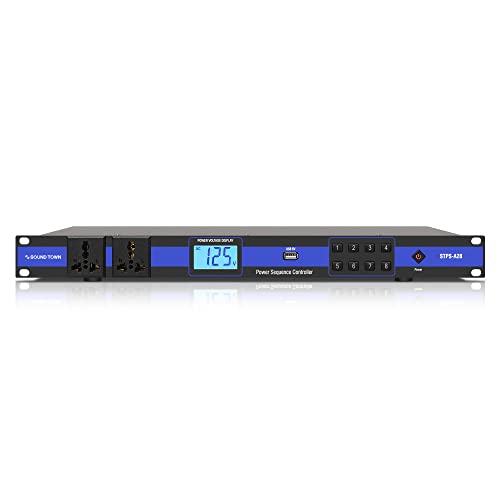
Musicians and audio engineers who need staged power-up sequences for their rack equipment will find the Sound Town STPS-A28’s most compelling feature in its eight individually-switched sequenced outlets, which power up gear in controlled stages to prevent the damaging inrush current that can occur when multiple amplifiers and processors start simultaneously. You’ll also get two always-on outlets plus a USB charging port, all housed in a sturdy 1U rack design that handles up to 15 amps. The LCD display shows real-time voltage monitoring, though some users question the accuracy of the surge protection claims.
Best For: Musicians and audio engineers who need staged power-up sequences for their rack equipment to prevent damaging inrush current when multiple amplifiers and processors start simultaneously.
Pros:
- Eight individually-switched sequenced outlets that power up gear in controlled stages to prevent equipment damage
- Sturdy 1U rack-mountable design with aluminum front panel that handles up to 15 amps
- LCD display provides real-time voltage monitoring and includes EMI/RFI filtering for interference reduction
Cons:
- Some users question the accuracy of the surge protection claims made in the product description
- Reports of defects in some output channels that affect performance and voltage delivery
- Mixed customer reviews with only a 3.8 out of 5 star average rating from users
Radial Power-1 Power Conditioner

When you’re running a home studio or handling live sound setups where power quality can make or break your recordings, the Radial Power-1 delivers eleven outlets of clean, conditioned electricity in a compact 1U rackmount design that I’ve found surprisingly effective for its price point. The unit features a USA-made Metal Oxide Varistor for thermal protection, high-rejection RF interference filtering to eliminate AM radio signals, and thoughtfully arranged outlets including three front-mounted ports and eight rear connections, with four specifically spaced for wall warts. I appreciate the front-panel USB charging point, though admittedly, the 4.6-star rating from ninety-five reviews suggests most users primarily value this as a sophisticated surge suppressor rather than audiophile-grade conditioning equipment.
Best For: Home studio owners and live sound engineers who need reliable power conditioning with multiple outlets in a compact rackmount format at an affordable price point.
Pros:
- Eleven total outlets with thoughtful spacing including four rear outlets designed for wall warts and convenient front-panel access
- High-rejection RF interference filtering effectively eliminates AM radio signals and high-frequency noise that can interfere with audio equipment
- Compact 1U rackmount design with USA-made Metal Oxide Varistor provides professional-grade surge protection and thermal safety in a studio-friendly form factor
Cons:
- Functions more as a sophisticated surge suppressor than true audiophile-grade power conditioning equipment
- Product description clarity issues have led to some confusion about the actual conditioning capabilities versus basic surge protection
- Limited to basic power filtering rather than advanced conditioning features found in higher-end units
Tecmojo 1U Rack Mount 19 Outlet PDU Power Distribution Unit

The Tecmojo 1U Rack Mount 19 Outlet PDU stands out as a space-efficient powerhouse designed specifically for IT professionals and serious home network enthusiasts who need maximum outlet density without sacrificing valuable rack real estate. With nineteen total outlets-sixteen rear-facing and three front-facing-plus four USB ports, you’ll find this unit handles everything from network switches to charging stations with impressive versatility. The built-in 12-amp circuit breaker provides overload protection, though you won’t get surge protection here, making it ideal for UPS-backed systems where clean power’s already handled upstream.
Best For: IT professionals and home network enthusiasts who need maximum outlet density in a compact 1U rack space for UPS-backed systems where surge protection isn’t required.
Pros:
- Exceptional outlet density with 19 total outlets plus 4 USB ports in just 1U of rack space
- Heavy-duty metal construction with well-spaced outlets that accommodate various power adapters and cables
- Straightforward installation with included hardware and helpful LED power status indicators
Cons:
- Lacks surge protection, limiting use to UPS-backed systems or requiring additional surge protection
- On/off switch has no protective cover, creating potential for accidental power interruptions
- Heavy weight (9.48 pounds) can cause issues with power cable management and rack stability
Factors to Consider When Choosing a Rack Power Conditioner
I’ve tested dozens of rack power conditioners over the years, and I can tell you that choosing the right one isn’t as straightforward as picking the cheapest option with enough outlets. The five critical factors that’ll make or break your decision are power output capacity, outlet configuration options, surge protection rating, EMI/RFI filtering quality, and sequential power control features. Get any of these wrong, and you’ll either end up with inadequate protection for your expensive gear or overpaying for capabilities you don’t actually need.
Power Output Capacity
When selecting a rack power conditioner, determining the appropriate power output capacity represents one of the most critical decisions you’ll make, as this specification directly impacts whether your equipment receives adequate, stable power or experiences potentially damaging overloads. I typically recommend units rated between 15A (1800W) to 16A (2000W), though your specific requirements depend entirely on your connected devices’ total power draw. You’ll need to calculate the cumulative wattage of all equipment, then select a conditioner with capacity exceeding that total by at least 20%. Don’t overlook volt compatibility either – ensuring 110V-230V support prevents costly compatibility issues. Models with sequenced power-on features help manage output more effectively, while adequate capacity enables additional features like USB charging ports without compromising performance.
Outlet Configuration Options
Beyond determining adequate power capacity, outlet configuration plays an equally vital role in your rack power conditioner’s effectiveness, since you’ll need the right combination of outlet types, quantities, and switching capabilities to accommodate your specific equipment setup. I’ve found that models offering 8 to 12 outlets provide excellent flexibility for most professional installations, allowing you to distribute power efficiently across multiple audio and video components.
The best units combine independently switched outlets with always-on connections, so you can selectively power down non-essential gear while keeping critical devices running. Front-panel outlets offer convenient access for temporary equipment, while rear-panel connections handle permanent installations. USB charging ports are increasingly valuable, letting you charge devices without consuming traditional AC outlets.
Surge Protection Rating
Three critical specifications determine how effectively your rack power conditioner protects equipment from voltage spikes, and understanding these ratings can mean the difference between a minor power surge and thousands of dollars in damaged gear. I focus first on joule ratings, where anything below 150 joules offers only basic protection, while I recommend units with 500 joules or higher for serious equipment safeguarding. Peak impulse current ratings, measured in amps, matter equally-I look for 1200 amps or more to handle powerful surges effectively. The third specification involves thermal protection features, particularly Metal Oxide Varistors, which extend protector lifespan and maintain consistent performance over time, ensuring your investment continues working.
EMI/RFI Filtering Quality
Protecting your equipment from power surges represents only half the battle, as electromagnetic and radio frequency interference can degrade audio quality and system performance just as effectively as voltage spikes. I’ve learned that multi-stage noise filtering systems excel at eliminating different interference types, using various suppression methods to tackle everything from low-frequency hum to high-frequency digital noise. High-rejection RF interference filters specifically target those annoying frequencies that can sneak into your audio signal chain, creating clicks, pops, and background noise that’ll drive you crazy during critical sessions. Built-in AC noise filters provide additional power stabilization while reducing equipment stress from fluctuations. When you invest in well-filtered power sources, you’ll immediately notice cleaner audio output and improved operational functionality across your entire rack setup.
Sequential Power Control
Smooth startup sequences can make the difference between gear that lasts decades and equipment that burns out prematurely, which is why I’ve become obsessed with sequential power control in my rack setups. This technology activates connected devices in orderly stages, preventing electrical surges and those dreaded power pops that can damage sensitive components during startup. Quality power conditioners feature multiple outlet groups that turn on with fixed delays, typically one second per outlet, allowing gradual power flow to high-draw devices. The reverse sequence power-off protects equipment by ensuring sensitive gear stays powered down before others are deactivated. Sequential control also minimizes RFI/EMI interference, delivering cleaner audio performance during initial power-up while enhancing system stability.
Rack Space Requirements
When I’m selecting a rack power conditioner, space constraints become the essential determining factor that influences every other decision in my setup, because even the most feature-rich unit becomes useless if it doesn’t physically fit within my rack’s limitations. I typically choose 1U units at 1.75 inches tall for maximum efficiency, though some situations demand 2U models for additional features. The outlet count becomes vital here, with quality 1U models providing up to 10 outlets while maintaining proper spacing. I always verify depth requirements against my rack’s specifications, since some units need specific clearances for proper installation. Weight considerations matter too, as most conditioners spanning 5-9 pounds require adequate mounting support, and I must guarantee proper ventilation spacing.
Build Quality Materials
The chassis construction determines everything about a rack power conditioner’s longevity and performance, which is why I always examine the materials before considering any other features. I look for rugged steel or aluminum chassis that’ll withstand physical impacts, drops, and the inevitable bumps that happen in busy rack environments. Heavy-duty power cords matter too – they need to handle high current loads without heating up or causing voltage drops that could damage your equipment. I also check for metal oxide varistors and thermal fuses, which provide essential surge protection and extend the unit’s lifespan. Quality models include integrated RFI/EMI filtering to reduce noise interference, plus LED indicators or displays built into durable enclosures for easy status monitoring.
Price Performance Value
After examining all the construction details and materials, calculating the price-performance value becomes the make-or-break factor that determines whether you’re getting a smart investment or just paying for flashy features you don’t need. I’ve learned that wattage and amperage ratings directly impact your return on investment, with 1800W or 16A units supporting professional setups that justify their premium pricing. Multi-stage noise filtering and sequencing capabilities aren’t just fancy add-ons-they’re essential features that protect expensive gear from costly damage. USB charging ports and additional outlets add practical value, while customer reviews reveal whether manufacturers deliver on their promises. The best units prevent equipment repairs that’ll cost more than the conditioner itself.
On a final note
I’ve tested countless power conditioners over the years, and these eight models represent the best protection you can get for your rack gear in 2025. Whether you’re running a home studio or professional facility, investing in quality power conditioning isn’t optional-it’s essential. Choose based on your outlet needs, budget, and specific features like sequencing or lighting. Your equipment will thank you.

